 .
. How many minutes are there in 1 microcentury?
~ 53 minutes, which approximately matches the length of this class.
LINEAR MOMENTUM
Although Newton had the option of writing down his Second Law of Motion
as the familiar ![]() ,
he chose to do it as:
,
he chose to do it as:  .
.
Arose from concept of a conserved quantity which he thought of as the "quantity of motion". Named it (linear) MOMENTUM. NOTE p is a vector!
Oppositely directed momenta can cancel; relative motion needs to be considered:
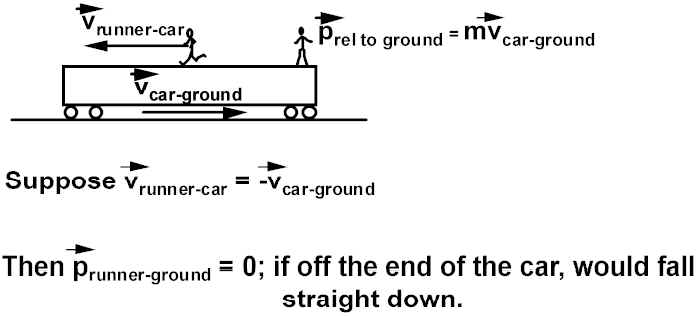
Momentum of a baseball thrown at (very) high speed due south : v = 46.3 m/s; m = 0.14 kg. Find p as it left pitcher’s hand: p = mv = 6.5 kg m/s, due south.
Now suppose a batter hits it back towards the pitcher at 50 m/s. Determine the final momentum and the change in momentum.
First what happened? Bat exerts a force on ball for a few ms:
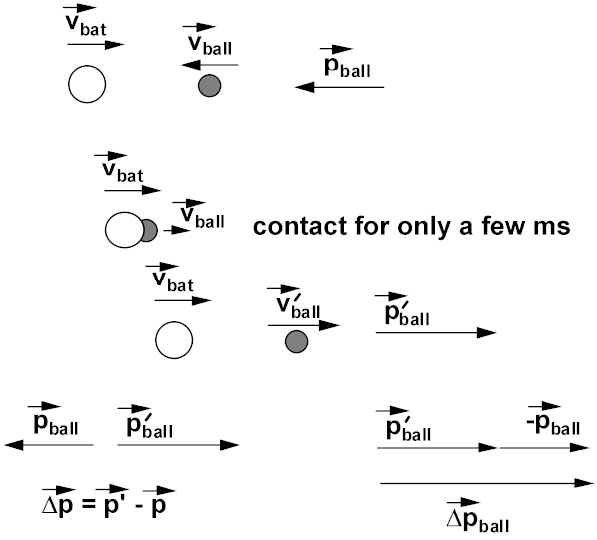
Magnitude of p’ = 50 m/s 0.14 kg = 7.0 kgm/s; direction: north.
Magnitude of
Dp = 13 kgm/s; Direction of Dp : north. (large changes when direction of motion reversed).So N2:  is read: rate of change of momentum with respect to time is
the net applied force, F
is read: rate of change of momentum with respect to time is
the net applied force, F
The NET force exerted on a body = the resulting change in momentum / time interval the force is applied.
In collisions,
Dt = collision time.If you want to understand this equation: play POOL!
("Dad, Honest!! My physics professor told be to go play pool!")
Note that ![]() . Left hand side called the "IMPULSE". Although we
are assuming Fext constant during a process, if we have a variable F vs time:
. Left hand side called the "IMPULSE". Although we
are assuming Fext constant during a process, if we have a variable F vs time:
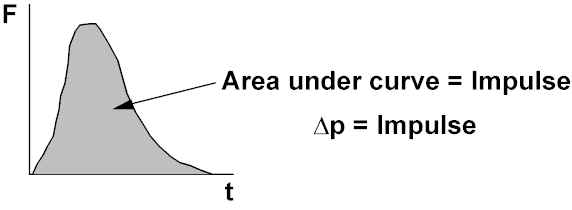
Implications: To get a desired
Dp, can use |F| and/or Dt to achieve.If you bring object to rest (rel. to earth) or if initially at rest, then F from that instant controls DIRECTION of v (p). (golf ball, tennis ball, thrown objects). Times of applied F vary in sports:
For example: once ball leaves (bat-foot-racket-hand) then mg takes over (or in isolated space or on a flat frictionless surface, N1 takes over).
To slow the Luner Excursion Module, falling towards the moon’s surface:
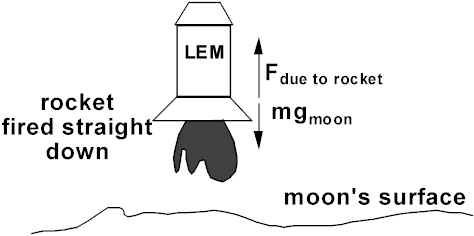
Conservation of Linear Momentum
Originally based on experiment; stated first by Descarte --clarified by Newton:
When the resultant of all external forces acting on a system is zero, the linear momentum of the system remains constant.
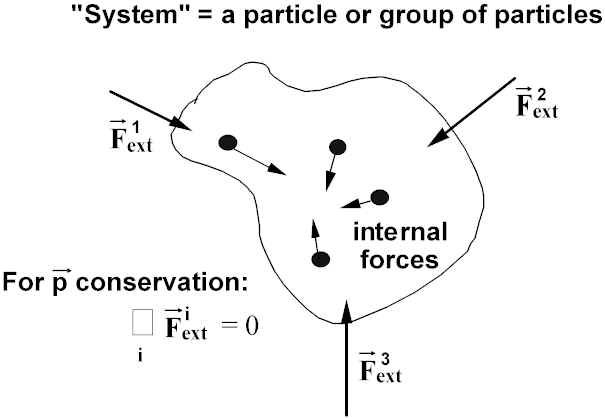
Comes about because in the isolated system, if A pushes on B to change the momentum of B, then by N3, B pushes on A to change the momentum of B by an equal and opposite amount.
Often can get a isolated system by including more of the environment (surroundings).
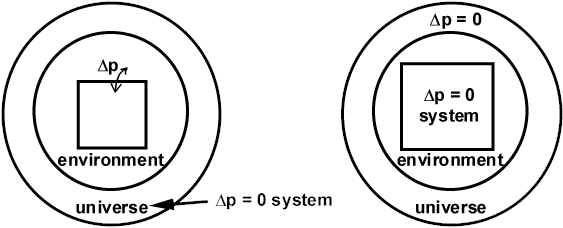
TWO OBJECTS: If m
1 with initial velocity![]() (1)
(1)
f == final, i == initial. The arrow over the ![]() means that the direction as
well as the magnitude of the velocity must be considered.
means that the direction as
well as the magnitude of the velocity must be considered.
Consider two astronauts, Myra and Mervin in isolated space with a Medicine Ball.
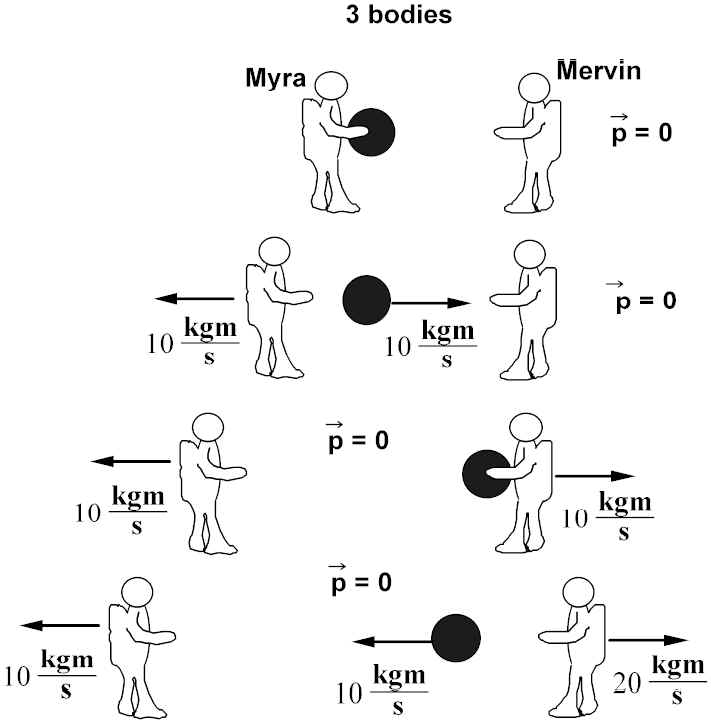
Taking Myra, Mervin, and the ball as the system, p=0 always. All forces are internal (pushing and catching the ball). Consider the ball as the system: forces change p all the time. Ball is not isolated.
Taking the (Moving Ball and Mervin) (2nd - 4th drawing): isolated, p = 10 kgm/s. Until Myra catches the ball and pushes it back, the ball and Mervin are isolated and concerve momentum.
Consider "Explosion" on Air Track

At t = 0, v
1 = v2 = 0; We burn thread. Spring stretches pushing with equal force on both masses (F1 = -F2). From Conservation of Momentum:

If m
2 > m1, then lighter mass m1 moves away faster than heavier one, m2. True of 3D Explosion (Star Wars), also.Totally Inelastic Collision: m
2 initially at rest:
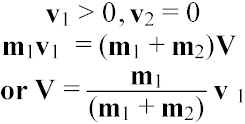
Stopping Things
When objects have p, to bring to rest (
Dp = p) requires application of an impulse: FDt = p.To prevent damage (injury), F < F
max.Therefore, to reduce F, INCREASE
Dt!!!!Safety Nets, Pole Vault Pit
Baseball Gloves
Boxing Gloves
Running Shoes
Helmuts
Shoulder Pads
Bumpers
Air Bags
In front end collision, without seatbelt, you become a projectile:
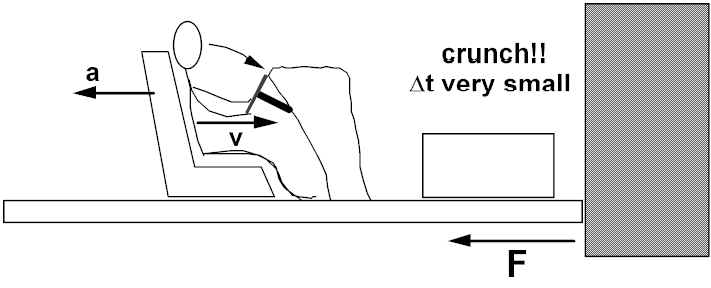
Longer contact time means reduced impact force -- less likely cause an injury.
Inflation of Bag: Must occur during deceleration of car and before head reaches wheel/dash (typically 0.05 s). Sensors detect sharp deceleration, send signals to a processor that looks for simultaneous warnings -- closes a switch that runs LARGE CURRENT in an igniter in the air bag. NaN
3 (sodium azide) powder explodes (decomposes rapidly) to yield tons of N2. Entire sequence takes only 0.025 s! Nylon bag dusted with corn starch to prevent sticking -- acts as a lubricant, to reduce time.Usual warning: Airbags only protect you for forward collisions (front end). ALWAYS WEAR YOUR SEAT BELTS!
Two body collision with energy conservation adds this equation:
![]() (2)
(2)
HOLDS ONLY IF COLLISION IS TOTALLY ELASTIC.
In one dimension, can solve for v
1f and v2f:

Special Cases:
m
1 = m2 = m; v2i = 0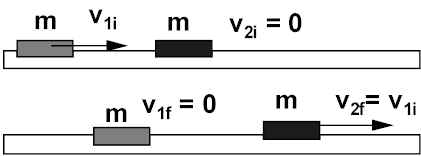
(direct hit on pool table)
m
1 = m2 = m; v2i = -v1i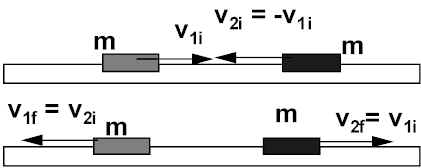
m
2 = infinity, v2i = 0 (Brick Wall):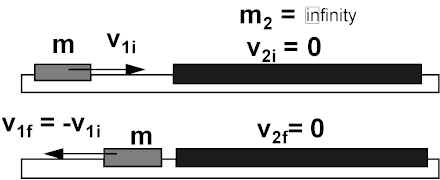
Ballistic Pendulum
A projectile of mass m and velocity v is fired into a large mass M suspended like a pendulum.
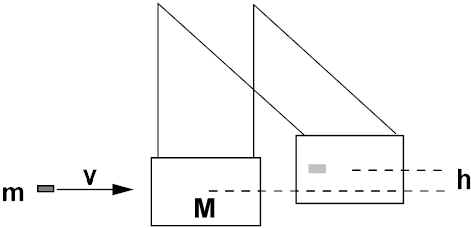
Totally Inelastic Collision; momentum conserv.: ![]() .
.
We assume m comes to rest before m+M starts moving; good approx. for M>>m.
But as soon as (m+M) starts to move, the string(s) cause (m+M) to lift to a maximum height, h. Energy conservation for this motion yields:
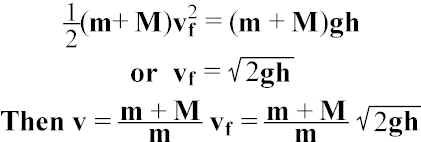
A 2000 kg Cadillac limousine moving east at 10 m/s collides with a 1000 kg Honda Prelude moving west at 26 m/s. The collision is completely elastic and takes place on an icy (frictionless) patch of road. Find the common velocity of the cars after the collision and the fractional loss in kinetic energy.

SOLUTION: Label initial velocities with the letter "u" and
the common final velocity as "![]() ". No friction on the road surface and gravity acts only
in the vertical direction, then there are no external horizontal forces, where system =
both cars. Therefore, momentum conserved:
". No friction on the road surface and gravity acts only
in the vertical direction, then there are no external horizontal forces, where system =
both cars. Therefore, momentum conserved:
m
1u1 - m2u2 = (m1 + m2)V(assuming V is in +x direction (to right).
Solve for V:
 Minus sign means that the cars actually
go in the -x direction or to the left after the collision.
Minus sign means that the cars actually
go in the -x direction or to the left after the collision.
Fractional change in kinetic energy:

(tremendous loss!!). The fractional change is:

Almost all of the energy associated with the motion of the cars turns into some other form of energy, i.e., deforming the cars since automobiles are designed to absorb energy in fenders and front body parts during a collision.
Center of Mass
For a collection of masses hooked together rigidly, we can find a point, the Center of Mass (c.m.), where all the mass (M) can be thought of as concentrated, as the object translates according to N2:
S
F = mac.m.The c.m. moves as though all mass were concentrated there,
acted on by resultant of external forces.
Consider a distribution of two masses connected by a massless bar:
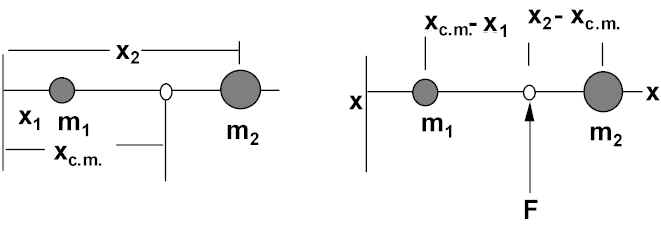
Suppose we apply force F at the point which we call the c.m. Then we want m
1 and m2 to both accelerate with a = F/(m1 + m2) and the bar will not rotate. This will occur when:
![]()
Note: m
1(xc.m. - x1) = m2(x2-xc.m.) or m1a(xc.m. - x1) = m2a(x2-xc.m.); means there are no torques about c.m., so bar will not rotate. Therefore when F applied at c.m., the system (m1,m2) moves with acceleration given byF=Mtotal a
For one D mass distributions:
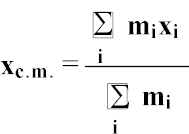
Collection of masses in two dimensions:

 and
and 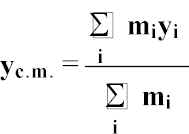
In gravitational field, all m
i experience mig force; If we apply a force F = Mtotal g at c.m., object will remain at rest and will not rotate. (we then call c.m. = c.g. ---center of gravity).Also, if you support an object at a point not = to c.m., object will rotate until c.m. is directly below point of support. Can use to find c.m. of 2-D objects by hanging from two points. If c.m. is below point of support, stable.
c.m. can lie outside body -- e.g., balancing forks, coat hanger on head.
If you launch objects with arbitrary forces, they rotate + translate. They rotate about c.m.; c.m. moves as if all mass were concentrated at c.m. (Throw a tennis racket or a wrench; your roommate).
Explosions of projectiles: c.m. keeps moving uneffected; fragments conserve momentum (p
o = 0 w.r.t. c.m.).Suppose two equal parts, tail part shoots straight down:
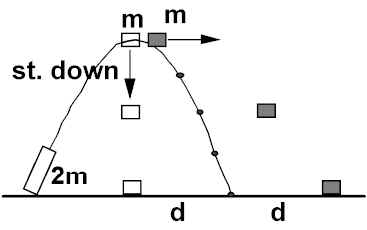
c.m. travels along parabola that 2m would have followed.
Cylinder on paper:
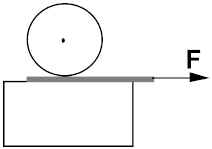
You pull paper, cylinder rolls backwards on paper; but relative to table F accelerates cylinder to right. (force on cylinder = f
friction which is to the right).
ROCKETS
Propelled by ejection of mass, usually in form of gas. (they do not move by pushing on ground or on atmosphere). Works anywhere.
1920 New York Times editorial advised Robert Goddard to give up thoughts of space travel -- "even a school boy knows that rockets obviously cannot fly in space because a vacuum is devoid of anything to push on." WRONG!!
It is the relative velocity of the ejected mass (relative to the rocket) that determines the Force pushing the rocket [CALLED THE THRUST!]
If
DM is the amount of mass being ejected in time Dt, and this is ejected (relative to the rocket) with velocity Vex,
then we can show:

A Centaur Rocket shoots hot gas from its engine at a rate of 1300 kg/s (this is
DM/Dt). Vex = 50,000 m/s (These are BIG numbers)F
thrust = 65 MN (this is about 7000 tons of force).Note that as time goes on, rocket gets lighter; therefore acceleration increases with time (for constant
DM/Dt).Reverse thrust: Used to decelerate: 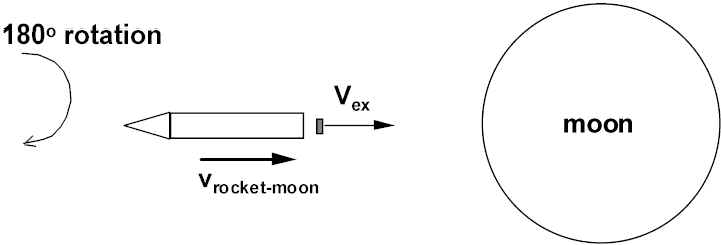
You have all experienced this when landing in airplane: Jet engines (or props) "reversed": flow of air deflected 180° by cowls or props rotated to "blow forwards". Generates Braking Impulse (Ft) -- wheel brakes could not generate nearly as much force.